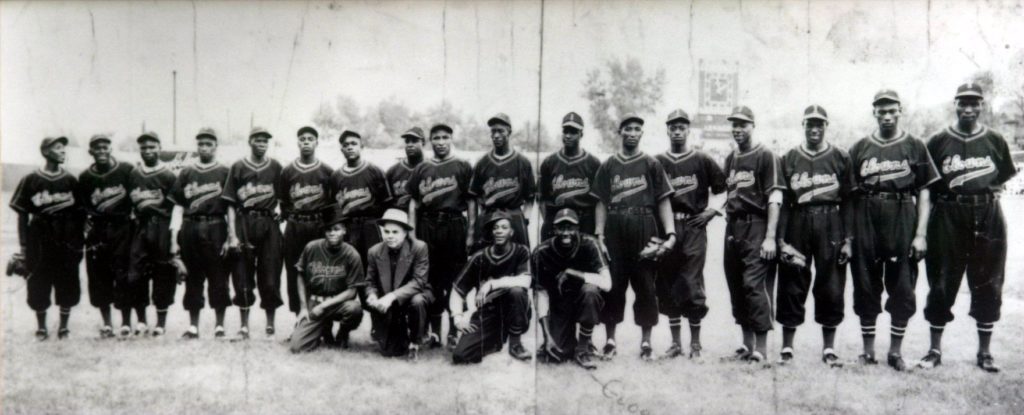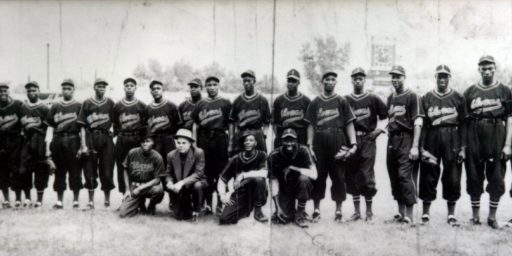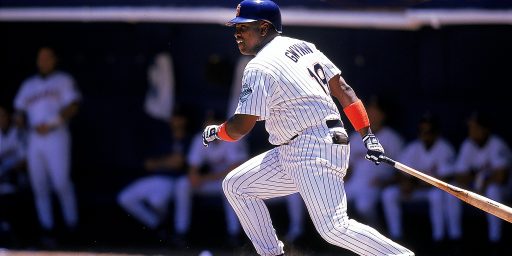MLB Upends Record Books
The inclusion of Negro League statistics has rewritten the game's history.

Back in December 2020, I noted baseball long-overdue recognition of the Negro Leagues as a major league, comparable to today’s National and American Leagues. Yesterday, Major League Baseball announced that it had taken the next step of integrating Negro League statistics into the MLB record book.
AP (“Josh Gibson becomes MLB career and season batting leader as Negro Leagues statistics incorporated“):
Josh Gibson became Major League Baseball’s career leader with a .372 batting average, surpassing Ty Cobb’s .367, when Negro Leagues records for more than 2,300 players were incorporated Tuesday after a three-year research project.
Gibson’s .466 average for the 1943 Homestead Grays became the season standard, followed by Charlie “Chino” Smith’s .451 for the 1929 New York Lincoln Giants. They overtook the .440 by Hugh Duffy for the National League’s Boston team in 1894.
Gibson also became the career leader in slugging percentage (.718) and OPS (1.177), moving ahead of Babe Ruth (.690 and 1.164).
“This initiative is focused on ensuring that future generations of fans have access to the statistics and milestones of all those who made the Negro Leagues possible,” baseball Commissioner Rob Manfred said in a statement. “Their accomplishments on the field will be a gateway to broader learning about this triumph in American history and the path that led to Jackie Robinson’s 1947 Dodger debut.”
A special committee on baseball records decided in 1969 to recognize six major leagues dating to 1876: the National (which launched in 1876), the American (1901), the American Association (1882-1891), Union Association (1884), Players’ League (1890), and Federal League (1914-1915). It excluded the National Association (1871-75), citing an “erratic schedule and procedures.”
MLB announced in December 2020 that it would be “correcting a longtime oversight” and would add the Negro Leagues. John Thorn, MLB’s official historian, chaired a 17-person committee that included Negro Leagues experts and statisticians.
“The condensed 60-game season for the 2020 calendar year for the National League and American League prompted us to think that maybe the shortened Negro League seasons could come under the MLB umbrella, after all,” Thorn said.
An updated version of MLB’s database will become public before the St. Louis Cardinals and San Francisco Giants play a tribute game to the Negro Leagues on June 20 at Rickwood Field in Birmingham, Alabama.
Baseball Hall of Fame President Josh Rawitch said statistics on Cooperstown plaques would remain the same because they reflect the information available at the time of a player’s induction.
Standards for season leaders is the same for Negro Leagues as the other leagues: 3.1 plate appearances or one inning for each game played by a player’s team.
Gibson’s .974 slugging percentage in 1937 becomes the season record, and Barry Bonds’ .863 in 2001 dropped to fifth, also trailing Mules Suttles .877 in 1926, Gibson’s .871 in 1943 and Smith’s .870 in 1929.
Bond’s prior OPS record of 1.421 in 2004 dropped to third behind Gibson’s 1.474 in 1937 and 1.435 in 1943.
Willie Mays gained 10 hits from the 1948 Birmingham Black Barons, increasing his total to 3,293. Minnie Minoso surpassed 2,000 hits, credited with 150 for the New York Cubans from 1946-1948 that boosted his total to 2,113.
Robinson, who broke MLB’s color barrier with the 1947 Dodgers, was credited with 49 hits with the 1945 Kansas City Monarchs that increased his total to 1,567.
Among pitchers, Satchel Paige gained 28 wins that raised his total to 125.
The committee met six times and dealt with issues such as when compiled league statistics didn’t make sense, such as a league having more wins than losses and walks that were missing. Researchers had to identify whether players with the same name were one person or separate, tracking dates of birth, and identify people listed by nicknames. Documenting transactions and identifying ballparks in a time when neutral sites often were used is ongoing, along with uncovering statistics for independent teams.
Kevin Johnson and Gary Ashwill, researchers who had spent nearly two decades helping assemble the Seamheads Negro Leagues Database, were included in the project.
Thorn estimated 72% of Negro Leagues records from 1920-1948 are included and additional research might lead to future modifications. Thorn said a four-homer game by Gibson in 1938 and a home run by Mays in August 1948 could not be included because complete game accounts have not been found.
“Without a box score, we can’t really balance the statistics,” Johnson said. “Those games are kind of in limbo at the moment.”
Records include the first Negro National League (1920-31), Eastern Colored League (1923-28), American Negro League (1929), East-West League (1932), Negro Southern League (1932), second Negro National League (1933-48) and Negro American League (1937-48).
Some game details were obtained from newspapers that covered the Black communities. Johnson said while complete accounts were found for about 95% of games in the 1920s, coverage dropped off during the Great Depression in the 1930s and never fully recovered.
This will surely upset some fans, as baseball, far more than any other American sport, thrives on statistical lore and comparisons of player performance over time. Gridiron football, far and away the most popular sport here, changes so much that records are constantly being broken. While every baseball fan knows the significance of 714, 755, 61, and .406,* few football fans could tell you how many yards Emmitt Smith rushed (18,355), how many touchdowns Jerry Rice scored (208), or how many passing yards Tom Brady had (89,214).
My baseball fandom peaked almost a quarter century ago and I’ve been a casual fan, at best, for the last two decades. While I haven’t given it much thought since, I remain where I was four years ago, thinking individual career achievements different from single-season records:
Honestly, there’s going to have to be a dual-entry system for some of these statistics. We’ve long had National League and American League records; adding Negro League records can be done in the same way. Opening Day is opening day; there are just two or three instead of one or two.
But the season stats are simply a different thing entirely. It’s one thing to count hits and runs and strikeouts into a player’s statistics. But it’s rather silly to pretend that averages achieved over 80 games are comparable to those achieved over 148 or 162 (indeed, the whole * thing with Roger Maris’ breaking Babe Ruth’s single-season home run record never went away).
While it’s debatable whether Negro League numbers are directly comparable to those of the contemporary white Major Leagues, the same is true to a lesser extent with the National and American Leagues, which also played separately until the World Series until 1997. But it seems obvious to me that career home runs, batting average, slugging percentage, runs scored, and the like are very different than things like a season batting average. We’ve seen countless Major League players carry .400-plus averages well into the season, only to hit a slump and fall short. A 162-game schedule is simply a brutal test of endurance.
At the same time, comparing the performances of athletes from 1900 and today is fraught. Today’s players have far better training regimens, travel and hotel accommodations, medical treatment, nutrition, and the like compared to their forebears of even thirty or forty years ago.
*Although my using those numbers are an indication of the effects the steroid era had on the game. While most remember Babe Ruth’s (714) and Hank Aaron’s (755) career home run records, Barry Bonds’ 762 comes with a huge asterisk. Regardless of the addition of the Negro League records, Ted Wiliams’ .406 remains the last time a Major League player finished the season batting over .400.






Speaking as a baseball fan, incorporating the Negro league records is not only fine, but overdue.
Baseball records already usually specify “Modern Era”, which dates from the founding of the American League in 1901 or the founding of MLB in 1903. And as you point out, whenever career records come up, fans will note if they are comparing a player in the 162 game era with one in the 148 game era. Will this add another complexity? Sure, but anyone who is serious about statistics knows that the rule changes, training regimes, advancements in sports medicine, and the rise of full time, well paid athletes has changed the game so significantly that any discussion of, say, Ohtani versus Ruth might be interesting, but in the end it is just an academic exercise. I don’t think it would be controversial to say that the best MLB team today would wipe the floor with the best of Ruth’s era. I’m not even sure it would be controversial to say that of the worst MLB team today.
I think players from the modern era would win against the early 1900s versions. However, Ohtani vs Ruth? Ohtani has already had 2 surgeries. If it was 1930 those wouldn’t be available and he wouldn’t even be playing. If you set records in those old days it was at least a partial testament to your endurance, even more than today.
I think for records set during a much shorter season they just need to have the number of games played prominently displayed. We already do that mentally for Maris.
Steve
Good.
@steve: [Warning: Baseball geeking out ahead] Like I said, such comparisons are interesting academic exercises in the real world. But as you point out, as soon as you start to take them too seriously you run into complications with no resolutions. Today, major league pitchers get Tommy Johns surgery because they throw the ball significantly faster than they did at the dawn of the radar gun era and, presumably, than the Ruth era, with more spin. And they can do that at the major league level in 30 games a year because they have the training regimens, CT scans, nutritional habits, management techniques and surgeries that allow them to endure it. So on the one hand, much more taxing on a day to day basis but on the other hand, a lot of knowledge and interventions that weren’t available back in the older era. How can you do an apples to apples given that?
We even have statistics that are much more recent that can’t be compared. Stolen basis are way up the past two years. But the bases got bigger, we got the pitch clock and the two-disengagements rule was implemented. Is if fair to compare today’s Elly de la Cruz to 1984’s Ricky Henderson? In fact, if you look at the history of stolen bases year by year, it’s pretty apparent there were big changes throughout baseball history that couldn’t be explained merely by talent. The National League had players with 100 bases a year at the start and then gradually declined to 16 in 1938, then gradually increased again in a ping pong fashion, finally holding more or less steady until 2017, when the modern statistics driven era revealed that attempting to steal was a net negative for almost every runner, something that had been true for decades but lost in the noise. In 2020 the NL record was 15 bases stolen. Which brings us to 2023 and increased base size, which made it worth a try again. And Elly de la Cruz has 31 stolen bases a third of the way through the season.
I propose that any run scored when the runner starts on 2nd base in the 10th inning* should be entered into the records as 1/2 run.
*Barf ball rule.
@Mister Bluster: How about a run scored after reaching first on a walk? 3/4?
😉
I just realized I never actually said what I thought about this: I think it is great and look forward to hearing a lot more about these guys.
And for anyone visiting Baltimore I recommend a pilgrimage to Peabody Heights Brewing in a building built on the site of the Internatial League Orioles (current Orioles are named after them but not the same team) and Negro National League Baltimore Elite Giants. Painted on the walls of the brewery are scenes and trivia from both teams.
@MarkedMan:
If you are ever anywhere near Kansas City, the Negro League Hall of Fame is a must visit. One admission gets you the NLHOF and the Jazz HoF next door. Another museum in KC that is a must to visit is WWI museum.
@MarkedMan:..3/4…
Starting a runner on second base in extra innings is supposed to make the game go faster. Apparently this is also the function of the lame ass pitch clock.
If Major League Baseball wants a game to end sooner they should call a batter out if he hits a foul ball on the third strike. Nobody wants to see a batter hit 16 foul balls in one at bat*.
I don’t want a baseball game to go faster. I want it to last forever.**
*I do. Watch Brandon Belt of the San Francisco Giants hit 16 foul balls off Los Angeles Angels of Anaheim California pitcher Jaime Barria in the 1st inning April 22,2018.
**Best game I ever saw on TV. April 17, 2010. Mets 2 – Cardinals 1 Final. 20 innings. First run of the game scored in the top of the 19th inning. I watched it at the Buffalo Wild Wings. Right about the 15th inning a couple were seated at the table next to me.
“We just came from that game.” (a two hour drive).
They ordered, dined and went home a few innings later.
@MarkedMan: A run that gets walked in should score 1 1/4 runs. 3/4s of a run is too little for that situation.
@Sleeping Dog:
Is the Steamboat Arabia museum still there? I really enjoyed that when I was in KC a few decades ago…
@DrDaveT:
It took me a minute to figure out what you were referring to, but to answer your question, I don’t know.